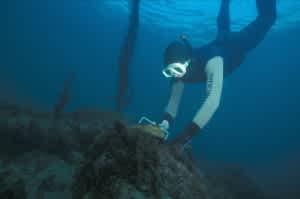California North Coast Abalone Season to Open; New Closure, Regulations in Effect
OutdoorHub 04.02.12

California’s popular red abalone sport fishery season will open April 1 in most waters north of San Francisco Bay. However, new regulations effective this year will close parts of Fort Ross State Historical Park to the take of abalone until June 1, 2012. A map of the closed area can be found online at http://nrm.dfg.ca.gov/FileHandler.ashx?DocumentID=42101&inline=true.
New Fish and Game regulations this year also mandate that every person taking abalone must maintain separate possession of their abalone prior to tagging. Abalone may not be commingled in a float tube, dive board, dive bag or any other container or device until after the abalone are properly tagged. While individual possession was a common practice in the past, it is now a legal requirement.
A complete list of abalone fishing regulations is available in the 2012 Ocean Sport Fishing Regulations booklet, which is available wherever fishing licenses are sold or atwww.dfg.ca.gov/marine/sportfishing_regs2012.asp.
Abalone licenses and report cards are available through the Department of Fish and Game (DFG) Automated License Data System (ALDS) which automatically enters purchases into an active database.
“Abalone report cards are a vital source of information needed to manage this resource and ALDS is a great tool which will allow us to track who has not returned their abalone card,” said DFG Environmental Scientist Jerry Kashiwada. “The cards are required to be returned to DFG by law, but in the past we could not easily determine who did not return their cards and compliance has been lower than needed for accurate catch estimates.”
Cards should be returned to DFG’s Fort Bragg office,32330 North Harbor Drive, Fort Bragg, CA 95437-5554. The return deadline is Jan. 31, 2013 but cards can be submitted early. Abalone report cards must be returned even if no abalone were taken or no attempt was made to take abalone.
The Fish and Game Commission is currently considering adoption of marine protected areas (MPAs) proposed along the north coast region (from Alder Creek/Point Arena, Mendocino County to the Oregon border). The proposals consider discrete areas that may restrict the take of abalone, but do not close the entire region to abalone harvest, and would not affect the 2012 abalone season. To find out more about specific MPA proposals and the location of proposed MPAs under consideration, please visit www.dfg.ca.gov/mlpa/northcoast.asp.
Abalone cling to rocks, from wave-swept intertidal ledges to deep ocean reefs, where they feed on kelp and other algae. It can take 12 years or more for abalone on the north coast to grow to legal size for harvest and biologists have concerns about the ability of the fishery to sustain current catch rates. Similar to rockfish, abalone are a long-lived species but have generally low rates of reproduction. The last major recruitment event for red abalone occurred more than 20 years ago and recent dive surveys have recorded lower densities of abalone at eight index sites.
Currently, the only sustainable abalone fishery in California is in the northern region of the state, which has remained productive for nearly 60 years. In 2010, the last year numbers are available, the catch estimated from abalone cards and telephone surveys was 234,000. The average catch has been about 264,000 annually for the past nine years.

